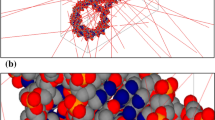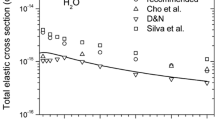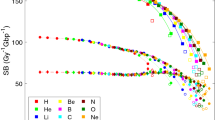Abstract
The quality of DNA damage induced by protons and α-particles of various linear energy transfer (LET) was studied. The aim was to single out specific lesions in the DNA molecule that might lead to biological endpoints such as inactivation. A DNA model coupled with a track structure code (MOCA-15) were used to simulate the lesions induced on the two helixes. Four categories of DNA breaks were considered: single-strand breaks (ssb), bluntended double-strand breaks (dsb, with no or few overlapping bases), sticky-ended double-strand breaks (with cohesive free ends of many bases), and deletions (complex lesions which involve at least two dsb within a small number of base pairs). Calculations were carried out assuming various sets of parameters characterizing the production of these different DNA breaks. No large variations in the yields of ssb and blunt- or sticky-ended dsb were found in the LET range between 10 and 200 keV/µm. On the other hand, the yield of deletions increases up to about 100 keV/µm and seems to reach a plateau at higher LET values. In the LET interval from 30 to 60 keV/µm, protons proved to be more efficient than α-particles in inducing deletions. The induction of these complex lesions is thus dependent not simply on LET but also on the characteristics of the track structure. Comparison with RBE values for cell killing shows that this special class of dsb might play an important role in radiation-induced cell inactivation.
Similar content being viewed by others
References
Barendsen GW (1964) Impairment of the proliferative capacity of human cells in culture bya-particles with differing linear energy transfer. Int J Radiat Biol 8:453–466
Barendsen GW (1994) The relationships between RBE and LET for different types of lethal damage in mammalian cells: biophysical and molecular mechanisms. Radiat Res 139:257–270
Belli M, Cera F, Cherubim R, Goodhead DT, Ianzini F, Jenner T, Moschini G, Sapora O, Simone G, Stevens DL, Stretch A, Tabocchini MA, Tiveron P (1992) Relevance of experiments with different charged particles having the same LET for biophysical modelling of radiation effects. In: Chadwick KH, Moschini G, Varma MN (eds) Biophysical modelling of radiation effects. Adam Hilger, Bristol, pp 285–292
Belli M, Cera F, Cherubini R, Ianzini F, Moschini G, Sapora O, Simone G, Tabocchini MA, Tiveron P (1994) DNA double-strand breaks induced by low energy protons in V79 cells. Int J Radiat Biol 65:529–536
Blöcher D (1982) DNA double-strand breaks in Ehrlich ascites tumour cells at low doses of X-rays. I. Determination of induced breaks by centrifugation at low speed. Int J Radiat Biol 42:317–328
Blöcher D (1988) DNA double-strand break repair determines the RBE of α-particles. Int J Radiat Biol 54:761–771
Bryant PE (1990) Restriction endonuclease- and radiation-induced DNA double-strand breaks and chromosomal aberrations: similarities and differences. In: Obe G, Natarajan AT (eds) Chromosomal aberrations: basic and applied aspects. Springer, Heidelberg New York Berlin, pp 61–69
Bryant PE, Johnston PJ (1993) Restriction-endonuclease-induced DNA double-strand breaks and chromosomal aberrations in mammalian cells. Mutation Res 299:289–296
Charlton DE, Humm JL (1988) A method of calculating initial DNA strand breakage following decay of incorporation125I. Int J Radiat Biol 53:353–365
Charlton DE, Nikjoo H, Humm JL (1989) Calculations of initial yield of single- and double-strand breaks in cell nuclei from electrons, protons and alpha particles. Int J Radiat Biol 56:1–19
Charlton DE, Nikjoo H, Goodhead DT (1991) Energy deposition in sub-microscopic volumes. In: Dewey WC, Edington M, Fry RIM, Hall EJ, Whitmore GF (eds) Radiation research: a twentieth century prospective, Vol 2. Academic Press, San Diego, pp 421–426
Cole A, Meyn RE, Chen R, Corry PM, Hittelman W (1980) Mechanism of cell injury. In: Meyn RE, Withers HR (eds) Radiation biology in cancer research. Raven Press, New York, pp 35–58
Cornforth MN, Goodwin EH (1991) The dose-dependent fragmentation of chromatin in human fibroblasts by 3.5 MeV α-particles from238Pu: experimental and theoretical considerations pertaining to single-track effects. Radiat Res 127:64–74
Durante M, Grossi GF, Napolitano M, Gialanella G (1991) Repair of potentially lethal damage by introduction of T4 DNA ligase in eucaryotic cells. Int J Radiat Biol 59:963–971
Frankenberg D, Frankenberg-Schwager M, Blöcher D, Adamczyk C (1980) Initial and irreparable double strand-breaks in the DNA of irradiation eukaryotic cells in dependence of dose rate and LET; implication for survival studies. Proc. 7th Symposium on Microdosimetry, p 1033
Frankenberg D, Frankenberg-Schwager M, Blöcher D, Harbich R (1981) Evidence for DNA double-strand breaks as the criticallesions in yeast cells irradiated with sparsely or densely ionising radiation under oxic or anoxic conditions. Radiat Res 88:524–532
Frankenberg-Schwager M (1990) Induction, repair and biological relevance of radiation-induced DNA lesions in eukaryotic cells. Radiat Environ Biophys 29:273–292
Goodhead DT (1984) Deduction from cellular studies of inactivation, mutagenesis, and transformation. In: Boice JD Jr, Fraumeni JF Jr (eds) Radiation carcinogenesis: epidemiology and biological significance. Raven Press, New York, pp 369–385
Hagen U (1994) Mechanisms of induction and repair of DNA double-strand breaks by ionizing radiation: some contradictions. Radiat Environ Biophys 33:45–61
Hamm RN, Turner JE (1992) Model calculation of radiation induced DNA damage. In: Chadwick KH, Moschini G, Varma MN (eds) Biophysical modelling of radiation effects. Adam Hilger, Bristol, pp 53–60
Henss S, Paretzke HG (1992) Biophysical modelling of radiation induced damage in chromosomes. In: Chadwick KH, Moschini G, Varma MN (eds) Biophysical modelling of radiation effects. Adam Hilger, Bristol, pp 69–76
Jenner TJ, Belli M, Goodhead DT, Ianzini F, Simone G, Tabocchini MA (1992) Direct comparison of biological effectiveness of protons and alpha particles of the same LET. III. Initial yield of DNA double-strand breaks in V79 cells. Int J Radiat Biol 61:631–637
Jenner TJ, deLara CM, O'Neil P, Stevens L (1993) Induction and rejoining of DNA double-strand breaks in V79-4 mammalian cells following γ and α irradiation. Int J Radiat Biol 64:265–273
Kampf G, Eichorn E (1983) DNA strand breakage by different radiation qualities and relations to cell killing: further results after the influence of α-particles and carbon ions. Stud Biophys 93:17–26
Kiefer J (1992) Heavy-ion effects on cells: chromosomal aberrations, mutations and neoplastic transformation. Rad Environ Biophys 31:279–288
Michalik V (1992) Model of DNA damage induced by radiations of various qualitites. Int J Radiat Biol 62:9–20
Napolitano M, Durante M, Grossi GF, Pugliese M, Gialanella G (1992) Inactivation of C3H 10T1/2 cells by monoenergetie high LET α-particles. Int J Radiat Biol 61:813–820
Neary GJ, Simpson-Gildemaister VF, Peacock AR (1970) The influence of radiation quality and oxygen on strand breakage in dry DNA. Int J Radiat Biol 18:25–40
Neary GJ, Horgan VJ, Bance DA, Stretch A (1972) Further data on DNA strand breakage by various radiation qualities. Int J Radiat Biol 22:525–537
Paretzke HG (1987) Radiation track structure theory. In: Freeman GR (ed) Kinetics of nonhomogeneous processes. Wiley, New York, pp 89–170
Roots R, Holley W, Chatterjee A, Irizarry M, Kraft G (1990) The formation of strand breaks in DNA after high-LET radiation: a comparison of data from in vitro and cellular systems. Int J Radiat Biol 58:55–69
Siddiqi MA, Bothe E (1987) Single- and double-strand breaks formation in DNA irradited in aqueous solution: dependence on dose and OH radical scavenger concentration. Radiat Res 112:449–463
Sontag W, Knedlitschek G, Weibezahn KF, Dertinger H (1990) The DNA content of some mammalian cells measured by flow cytometry and its influence on radiation sensitivity. Int J Radiat Biol 57:1183–1193
Wulf H, Kraft-Weyrather W, Miltenburger HG, Blakely EA, Tobias CA, Kraft G (1985) Heavy ion effects on mammalian cells: inactivation measurement with different cell lines. Radiat Res 104:S122–134
Yang TC, Craise LM, Mei M, Tobias CA (1989) Neoplastic cell transformation by high-LET radiation: molecular mechanisms. Adv Space Res 9:131–140
Author information
Authors and Affiliations
Rights and permissions
About this article
Cite this article
Ottolenghi, A., Merzagora, M., Tallone, L. et al. The quality of DNA double-strand breaks: A Monte Carlo simulation of the end-structure of strand breaks produced by protons and alpha particles. Radiat Environ Biophys 34, 239–244 (1995). https://doi.org/10.1007/BF01209749
Received:
Accepted:
Issue Date:
DOI: https://doi.org/10.1007/BF01209749




